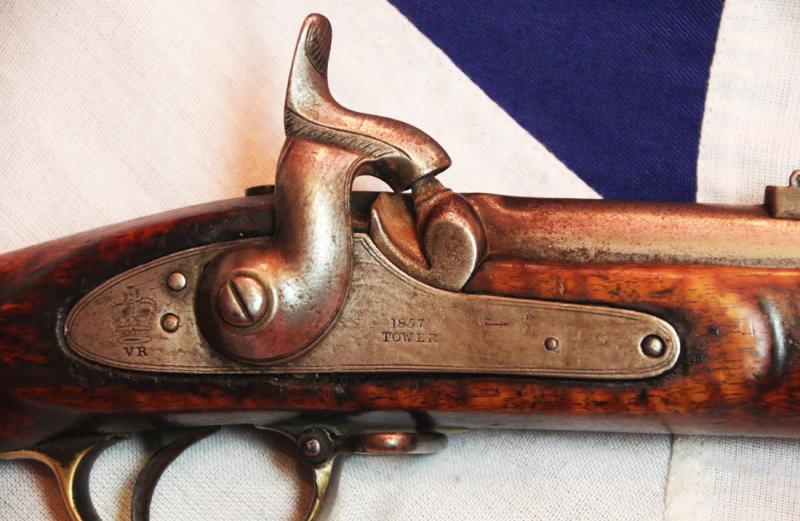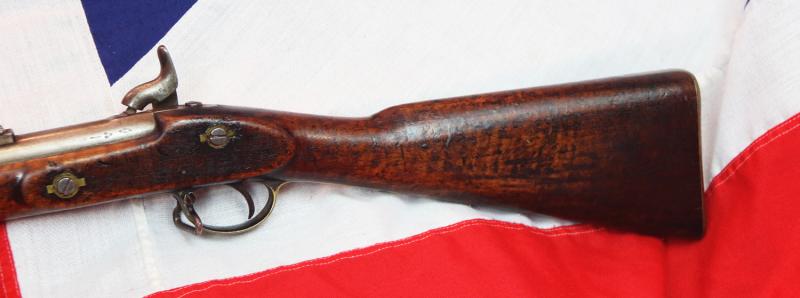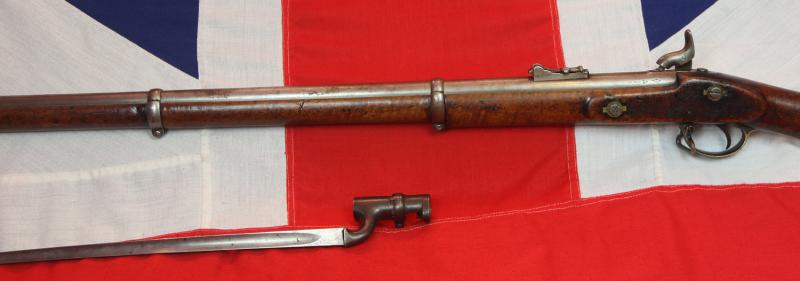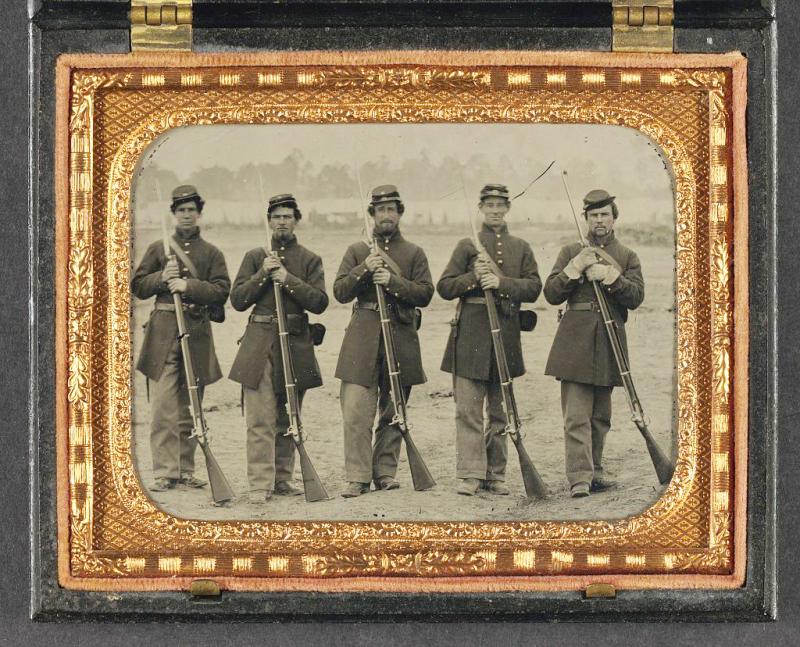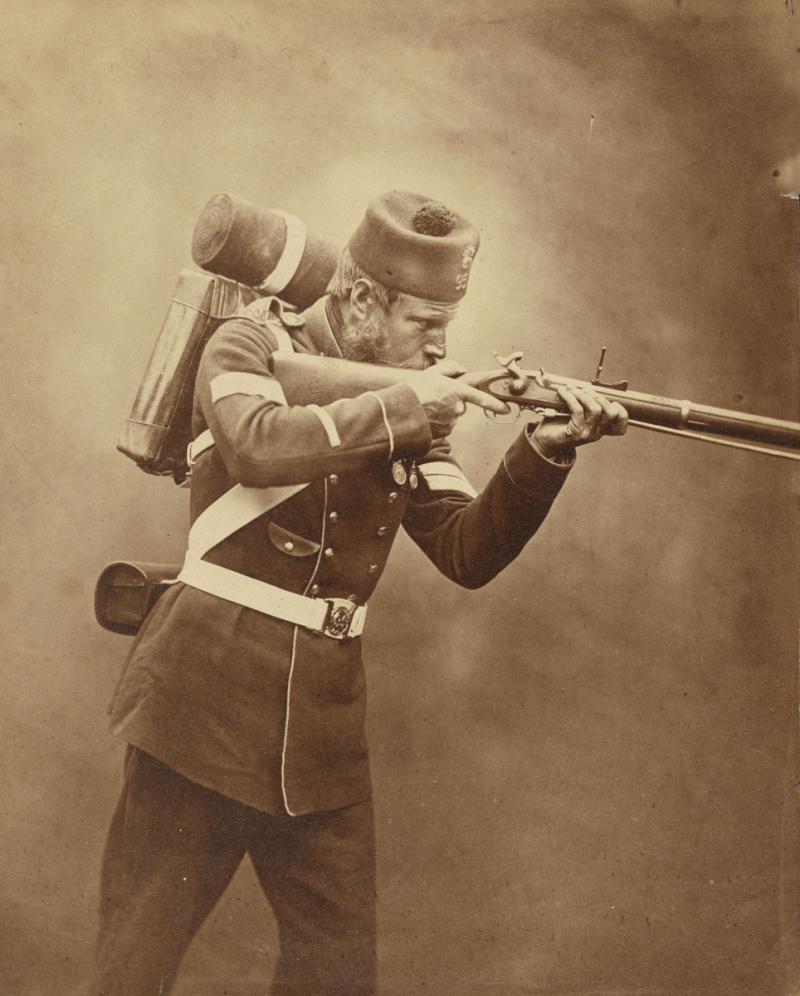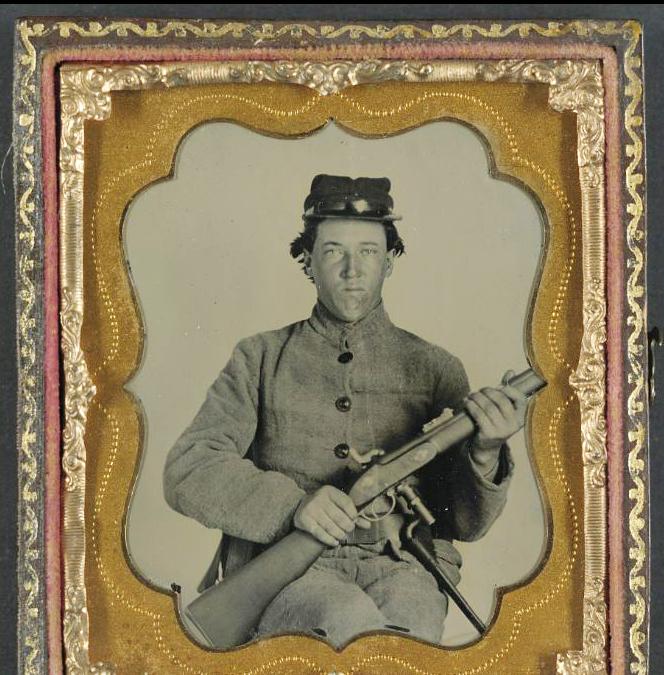A Stunning, Victorian '3 Band' Rifle From the Tower of London Armoury, With Original Bayonet.
Tower of London manufactured and dated 1857, with VR Crown stamp, and the butt has a War Office stamp and date, 1861, possibly when it was further inspected in Birmingham by the War Office inspector, and deemed suitable to export to the US Civil War. The War Office was a department of the British Government responsible for the administration of the British Army from 1857
The 'Enfield 1853' Pattern Rifle-Musket was the mainstay of the British Army and militia during the Crimean War and Indian Mutiny. It was later replaced briefly by the 2 Band, the Snider conversion and ultimately by the Martini Henry 450 577. This example is very attractive with it's original bayonet marked, and ramrod, profusely and fully ordnance marked throughout by the ordnance inspectors, and bears the stock roundel stamp on the butt, although this is very dark and difficult to read.
With war breaking out between the Turks and the Russians, Britain realized that it was only a matter of time before they would be drawn into the conflict. The British Army was in the midst of a significant weapons transformation from smoothbore muskets to rifled muskets. While three of the four divisions of the field army in the Crimea had been supplied with the pattern 1851 Minie rifle-musket, the other regiments of the army around the Empire still carried the 1842 pattern smoothbore musket. By the end of 1853, the Enfield rifle-musket was approved by the War Department for the army and was put into production. The Enfield saw extensive action in the Crimean War, 1854–1856, with the first Enfield rifles being issued to troops from February 1855
It was a rifle that was also used by both the North and the South in the American Civil War, and was the second most widely used infantry weapon in the war, surpassed only by the Springfield Model 1861 Rifled Musket. The Confederates imported more Enfields during the course of the war than any other small arm, buying from private contractors and gun runners when the British government refused to sell them arms after it became obvious that the Confederacy could not win the war. It has been estimated that over 900,000 P53 Enfields were imported to America and saw service in every major engagement from the Battle of Shiloh (April, 1862) and the Siege of Vicksburg (May 1863), to the final battles of 1865. At the Battle of Gettysburg on July 2, 1863, the 20th Maine Volunteer Infantry, led by Colonel Joshua L. Chamberlain, were armed with Enfield 1853 Rifle-Muskets during their famous bayonet charge against a relentless attack by Confederate Forces attempting to destroy the left flank of the Union Army on Little Round Top. Here is an excerpt from Chamberlain's Official Battle Report:
"The intervals of the struggle were seized to remove our wounded (and those of the enemy also), to gather ammunition from the cartridge-boxes of disabled friend or foe on the field, and even to secure better muskets than the Enfields, which we found did not stand service well."
The ferocious charge of the 20th Maine, with bayonets fixed to their Enfield Rifle-Muskets, was victorious against the stunned Confederates, and Colonel Chamberlain received the Medal of Honor for his day on Little Round Top. The P53 Enfields capabilities were largely lost by the lack of marksmanship training by both the Union and Confederacy. Most soldiers were not trained to estimate ranges or to properly adjust their sights to account for the "rainbow-like" trajectory of the large calibre conical projectile. Unlike their British counterparts who attended extensive musketry training, new Civil War soldiers seldom fired a single cartridge until their first engagement. After the end of the war, hundreds of formerly Confederate Enfield 1853 muskets were sold from the American arms market to the Tokugawa shogunate, as well as some prominent Japanese domains including Aizu and Satsuma. These units were later used in the Boshin War, and some remaining in Satsuma were also used by rebelling former samurai in the Satsuma Rebellion about a decade later.
The Enfield Pattern 1853 rifle-musket (also known as the Pattern 1853 Enfield, P53 Enfield, and Enfield rifle-musket) was a .577 calibre Minié-type muzzle-loading rifled musket, used by the British Empire from 1853 to 1867; after which many were replaced in service by the cartridge-loaded Snider–Enfield rifle.
History and development
The parts of the Enfield cartridge, including the papers, the Pritchett bullet, and forming tools
The term "rifle-musket" originally referred to muskets with the smooth-bored barrels replaced with rifled barrels. The length of the barrels were unchanged, allowing the weapons to be fired in ranks, since a long rifle was necessary to enable the muzzles of the second rank of soldiers to project beyond the faces of the men in front. The weapon would also be sufficiently long when fitted with a bayonet to be effective against cavalry. Such weapons manufactured with rifled barrels, muzzle loading, single shot, and utilizing the same firing mechanism, also came to be called rifle-muskets.
Royal Small Arms Factory developed the Pattern 1853 Enfield in the 1850s. The 39 in (99 cm) barrel had three grooves, with a 1:78 rifling twist, and was fastened to the stock with three metal bands, so that the rifle was often called a "three band" model. The rifle's cartridges contained 2+1⁄2 drams, or 68 grains (4.4 g) of gunpowder, and the ball was typically a 530-grain (34 g) Boxer modification of the Pritchett & Metford or a Burton-Minié, which would be driven out at approximately 1,250 feet (380 m) per second.
The original Pritchett design was modified by Col. Boxer, who reduced the diameter to 0.55 after troops found the original 0.568 too hard to load during the Indian Mutiny, changing the mixed beeswax-tallow lubrication to pure beeswax for the same reason, and added a clay plug to the base to facilitate expansion, as the original Pritchett design, which relied only on the explosion of the charge, was found to cause excessive fouling from too slow an expansion, allowing unburnt powder to escape around the bullet. The Enfield's adjustable ladder rear sight had steps for 100 yards (91 m) – the first position – 200 yards (180 m), 300 yards (270 m), and 400 yards (370 m). For distances beyond that, an adjustable flip-up blade sight was graduated (depending on the model and date of manufacture) from 900 yards (820 m) to 1,250 yards (1,140 m). British soldiers were trained to hit a target 6 feet (180 cm) by 2 feet (61 cm) – with a 2 feet (61 cm) diameter bull's eye, counting 2 points – out to 600 yards (550 m). The target used from 650 yards (590 m) to 900 yards (820 m) had a 3 feet (91 cm) bull's eye, with any man scoring 7 points with 20 rounds at that range being designated a marksman
As with all our antique guns no license is required as they are all unrestricted antique collectables.
The external finish is very good with much original varnish to the stock, with signs of use and wear naturally. The action was rather clogged and it is in the gun workshop being serviced, the spring is excellent and action tight as a drum.
Code: 24897



